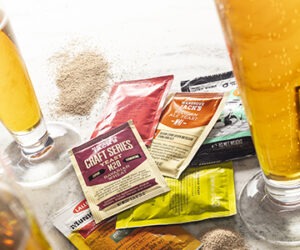Fermentation Timeline
What is yeast doing during beer fermentation? It is consuming wort sugars and turning that sugar into new yeast cells, ethanol, CO2, and flavor compounds. Brewers are primarily concerned with flavor compounds. To maximize the correct flavor compounds, it is helpful to know how yeast ferments beer.
Ale fermentation of brewer’s wort follows three phases: lag phase for three to 15 hours, exponential growth phase for one to four days, and stationary phase of yeast growth for three to 10 days. Here’s a brief look at each of the phases in terms of yeast behavior.
Lag Phase: Three to 15 Hours After Pitching Yeast
When yeast are pitched into beer they begin a process of acclimation to the environment known as the lag phase. Yeast begin to uptake minerals and amino acids from wort. Amino acids are used to build proteins. The amino acids that yeast either can’t obtain or can’t get fast enough from wort need to be manufactured by the yeast. Much the same way that humans need 100 percent of essential vitamins and minerals to make it though the day, yeast cells also need 100 percent of their vitamins and minerals (nutrients) to make it through a fermentation properly nourished.
All-malt wort is an excellent source of nitrogen, vitamins, and minerals. Most of the vitamins yeast need for proper fermentation are supplied in wort. Some examples of necessary vitamins are riboflavin, insositol, and biotin. Important minerals are phosphorous, sulphur, copper, iron, zinc, potassium, and sodium.
As the vitamins and minerals are taken up from wort, yeast begins to manufacture enzymes necessary for growth. Wort can be supplemented with additional vitamins and minerals by using commercially available yeast nutrients, which will improve the health and performance of yeast.
Oxygen is rapidly absorbed from the wort during the lag phase. The yeast need this oxygen to grow and to produce important cell wall constituents. It is important to introduce enough oxygen into wort at the beginning of fermentation. Shaking the fermenter will, at best, add about half the recommended level of 10 parts per million oxygen into solution. This will produce satisfactory fermentation results, but to make sure a healthy fermentation will take place, oxygen can be added to the fermenter with any of several commercially available systems.
The lag phase can be carried out at a higher temperature than the rest of fermentation because very few flavor compounds are produced. Ethanol production is also very limited, therefore ester formation is not a concern. Some brewers begin the lag phase for ales at 72° to 75° F and complete the fermentation at 68° F. This can be done successfully for lagers, starting the lag phase at 72° to 75° F and lowering the fermentation temperature to 50° to 55° F.
Brewers will not see any visible activity during the lag phase, hence the name. But this phase is very important in building new, healthy cells able to complete fermentation. If too much yeast is pitched, this will decrease the lag phase, and each individual cell will not be as healthy at the end of fermentation. Although it may be reassuring to see fermentation activity within one hour of pitching, it is not best for the yeast. (It is very difficult for homebrewers to overpitch — even three pints of active slurry is not too much.)
Exponential Growth Phase: One to Four Days
As the yeast comes out of the lag phase, it starts to consume the sugars in solution. CO2 is produced, which starts to dissipate through the airlock and create a surface layer of foam on the beer. The exponential, or logarithmic, phase of yeast growth is now starting. During this phase, the cell count increases rapidly and ethanol and flavor compounds are produced. Airlocks bubble like crazy during this time frame. The aroma that escapes from the airlock of most neutral ale yeast fermentations has an olive smell.
The exponential phase occurs because yeast rapidly consume sugar. Wort sugar is consumed by yeast in a certain pattern. Glucose is used first, then fructose and sucrose. These are simple sugars and can be quickly shuttled into metabolism. The glucose concentration in wort is roughly 14 percent of wort sugars.
Maltose is the centerpiece sugar of malt and is a very important flavor component. It makes up 59 percent of wort sugars, and its use by yeast gives beer its characteristic flavors. There are one to five genes in yeast DNA that “turn on” in response to maltose, allowing for fermentation by brewer’s yeast. After maltose enters the cell through a special uptake mechanism, it is hydrolyzed into glucose units by maltase enzymes. Glucose can then enter the normal metabolism cycle.
Maltotriose is fermented last. This is a tricky sugar for yeast to digest, and some yeast ferment maltotriose better than others. Some strains of brewer’s yeast do not ferment maltotriose at all. The more flocculent a yeast strain, the less maltotriose it tends to ferment. The ability to ferment maltotriose gives each strain its characteristic attenuation range.
At the height of activity, the beer is said to be at “high kraeusen.” The head of foam on top of the fermentation turns yellow to brown. The colors stem primarily from precipitated malt and hop components. Brown spots form from oxidized hop resins.
Stationary Phase of Yeast Growth: Three to 10 Days
At this point yeast growth slows down, and yeast enter into a stationary phase of growth. Most of the flavor and aroma compounds have been produced, including fusel alcohols, esters, and sulfur compounds. The beer is referred to as green because it does not yet have the acceptable balance of flavors.
Beer is matured in the stationary phase of growth, also known as the conditioning phase. Yeast reabsorb diacetyl that was produced during fermentation, and hydrogen sulphide escapes from the top of the fermenter as a gas. The kraeusen falls, and yeast begin to settle out, or flocculate. It is important to check the degree of attenuation at this point (by measuring gravity) to confirm that the yeast has completed fermentation. Some strains of yeast begin to flocculate before terminal gravity has been reached and need to be “roused” back into solution.
Professional breweries cool the contents of the fermenter gradually to 35° to 40° F, which forces most of the yeast to flocculate. Most homebrewers do not have the facilities to do this, so they must wait for the fermenter to “clear.” If the homebrew is to be bottled, flocculation can be allowed to complete in the bottles.



